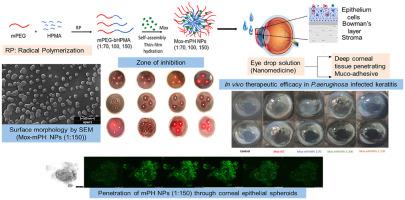Colloids and Surfaces B: Biointerfaces ( IF 5.4 ) Pub Date : 2021-09-14 , DOI: 10.1016/j.colsurfb.2021.112113 Sanjay Ch 1 , Priyasha Mishra 2 , Himanshu Bhatt 1 , Balaram Ghosh 1 , Sanhita Roy 3 , Swati Biswas 1

|
Bacterial keratitis (BK) is a leading cause of visual impairment. The fluoroquinolone antibiotic moxifloxacin (Mox), being highly water-soluble, suffers from poor corneal penetration leading to unsatisfactory therapeutic outcomes in BK. Here, we prepared Mox-loaded co-polymeric nanoparticles (NPs) by entrapping the drug in co-polymeric NPs constituted by the self-assembly of a water-soluble copolymer, poly(ethylene glycol)-b-p(hydroxypropyl) methacrylamide (mPH). The polymer (mPH) was prepared using a radical polymerization technique at different mPEG: HPMA ratios of 1:70/100/150. The polymer/nanoparticles were characterized by GPC, CAC, DLS, SEM, XRD, DSC, FTIR, % DL, % EE, and release studies. The ex vivo muco-adhesiveness and corneal permeation ability were judged using a texture analyzer and Franz Diffusion Cells. In vitro cellular uptake, cytotoxicity, and safety assessment were performed using HCE cells in monolayers, spheroids, and multilayers in transwells. The DOE-optimized colloidal solution of Mox-mPH NPs (1:150) displayed a particle size of ~116 nm, superior drug loading (8.3%), entrapment (83.2%), robust mucoadhesion ex vivo, and ocular retention in vivo (~6 h) (judged by in vivo image analysis). The non-irritant formulation, Mox-mPH NPs (1:150) (proven by HET-CAM test) exhibited intense antimicrobial activity against P. aeruginosa, S. pneumoniae, and S. aureus in vitro analyzed by live-dead cells assay, zone of inhibition studies, and by determining the minimum inhibitory and bactericidal concentrations. The polymeric nanoparticles, mPH (1:150), decreased the opacity and the bacterial load compared to the other treatment groups. The studies warrant the safe and effective topical application of the Mox-mPH NPs solution in bacterial keratitis.
中文翻译:

羟丙基甲基丙烯酰胺基共聚物纳米颗粒负载莫西沙星作为黏膜粘附性、角膜穿透性纳米药物滴眼液,对细菌性角膜炎具有增强的治疗效果
细菌性角膜炎 (BK) 是视力障碍的主要原因。氟喹诺酮类抗生素莫西沙星 (Mox) 具有高度水溶性,角膜渗透性差,导致 BK 的治疗效果不理想。在这里,我们通过将药物包裹在由水溶性共聚物、聚(乙二醇)-b -p(羟丙基)甲基丙烯酰胺自组装构成的共聚纳米颗粒中来制备负载 Mox 的共聚纳米颗粒(NPs)。英里/小时)。聚合物 (mPH) 是使用自由基聚合技术在不同的 mPEG:HPMA 比率为 1:70/100/150 下制备的。聚合物/纳米颗粒通过 GPC、CAC、DLS、SEM、XRD、DSC、FTIR、% DL、% EE 和释放研究进行表征。在体外使用质地分析仪和 Franz 扩散池判断粘液粘附性和角膜渗透能力。体外细胞摄取、细胞毒性和安全性评估是使用 HCE 细胞在单层、球体和 transwells 中的多层进行的。MOX-MPH NP的DOE-优化胶体溶液(1:150)中显示〜116纳米,优异的载药量(8.3%),包封(83.2%),健壮粘膜粘附的颗粒尺寸离体,和眼保留在体内( ~6 h)(通过体内图像分析判断)。无刺激性配方 Mox-mPH NPs (1:150)(通过 HET-CAM 测试证明)在体外对铜绿假单胞菌、肺炎链球菌和金黄色葡萄球菌表现出强烈的抗菌活性通过活死细胞分析、抑菌圈研究和测定最低抑菌浓度和杀菌浓度进行分析。与其他处理组相比,聚合物纳米粒子 mPH (1:150) 降低了不透明度和细菌负荷。这些研究保证了 Mox-mPH NPs 溶液在细菌性角膜炎中的安全有效的局部应用。











































 京公网安备 11010802027423号
京公网安备 11010802027423号